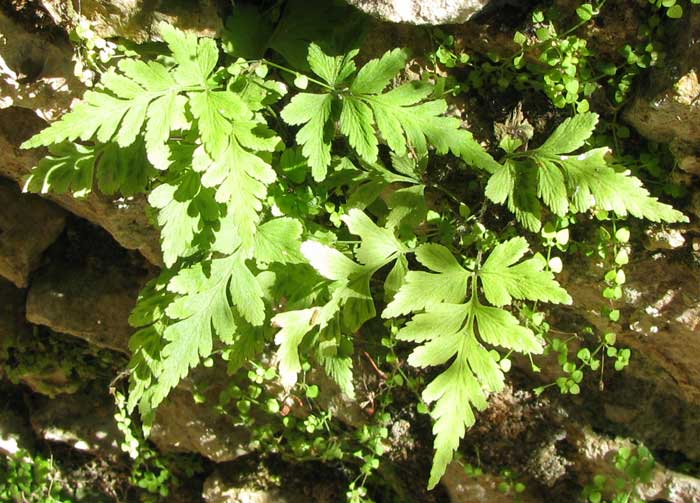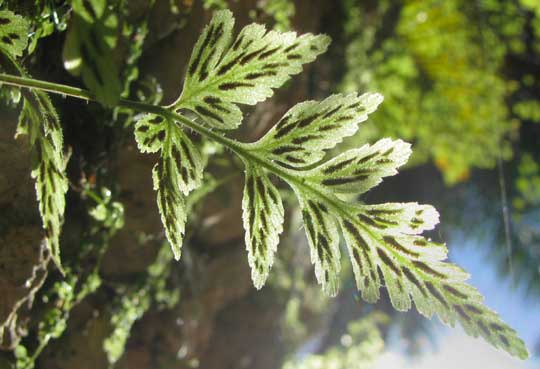Excerpts from Jim Conrad's
Naturalist Newsletter

from the December 12, 2010 Newsletter issued from Hacienda Chichen Resort beside Chichén Itzá Ruins, central Yucatán, MÉXICO; limestone bedrock, elevation ~39m (~128ft), ~N20.676°, ~W88.569°
TRIANGLE SPLEENWORT
Often visitors to the bathroom next to the Hacienda office pause to view the heavily shaded, eight-ft-high stone wall next to the bathroom. The wall is mantled with a luxuriant community of ferns, mosses and other tender, shade-loving herbs. Having passed the wall at least twice a day for the last year I felt sure I'd registered every plant there larger than an ant, but this week something new caught my eye. It was a fern, its smallish, deeply incised, triangular fronds shown above.
It wasn't the fronds' shapes that aroused my interest, because lots of ferns during the early stages of their development produce similarly small, triangular fronds. What struck me as unusual was the fact that the fronds bore sori -- spore-producing "fruit dots" on their lower surfaces. If these were immature fronds of fern species I'd already seen there, they wouldn't have born sori. Previously I'd not identified a fern whose mature fronds were so small and triangular shaped. This was something new.
Viewing a frond from below, with sunlight from above highlighting the sori, I saw what's shown below:

A close-up of some sori is below:

The brown, granular items spilling from beneath that curious, whitish, cellophane-like strip -- the indusium -- are not spores. They are baglike sporangia, which when mature snap open and release spores. Each sporangium contains 64 spores, so clearly fern spores are very tiny things.
Despite the fronds' small size and triangular shape ringing no bells with me, those sori looked very familiar. In the woods of both my childhood home in Kentucky and around my hermiting camps in Mississippi, one of the most common species was the Ebony Spleenwort, Asplenium platyneuron. Though its fronds were very different, its sori were the same -- long, slender, with silvery indusia along one side. You can see how similar an Ebony Spleenwort's sori are -- shown close-up in the second picture -- to this fern's at www.backyardnature.net/n/x/ebony-sp.htm.
The Spleenwort genus Asplenium is a big one, with about 700 species known worldwide, some 28 of which occur in North America. Frond shape in the genus is extremely diverse among the species, ranging from simple, undivided, ribbon-like blades, to "four-pinnately compound" -- the leaflets, or "pinnae," divided into further pinnae, which are divided into further pinnae, which are divided into further pinnae. Well, with such a big, variable genus, I figured that a good guess was that any fern, whatever its fronds' shape, if it bore sori like a spleenwort, probably it WAS a spleenwort.
And such was the case. Our wall fern turned out to be the Triangle Spleenwort, also called Hairy Spleenwort, ASPLENIUM PUMILUM. The online Flora of North America describes its habitat as shaded limestone boulders at or near sea level, so our shaded limestone walls have every reason to be home to the species. Triangle Spleenworts occur from a few spots in north-central Florida and Mexico south through the West Indies and Central America into South America.